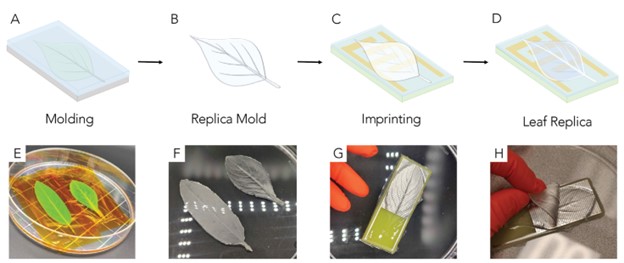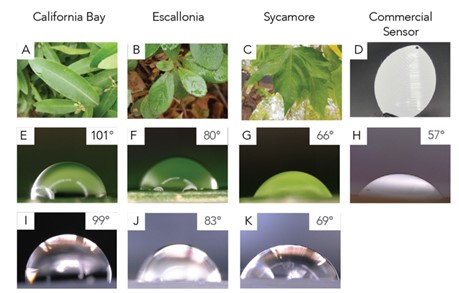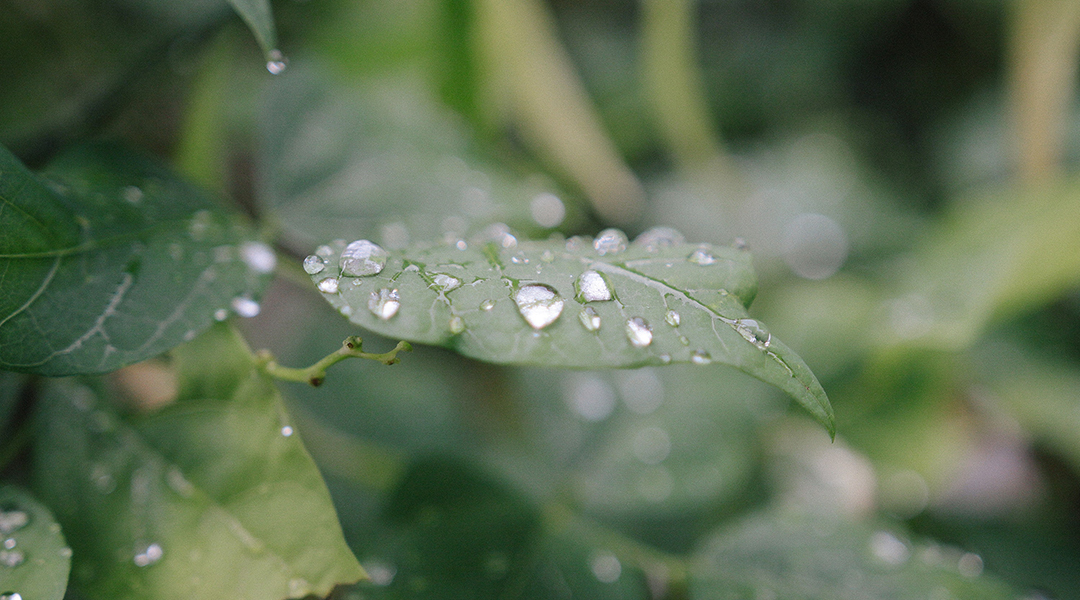In agriculture, excess water provokes plant disease, leading to lower crop yield and an estimated global annual loss of hundreds of billions of dollars. This happens because wet leaves present optimal conditions for pathogens. By closely controlling the time water remains on the leaf surface after rain or irrigation, not only can crop loss be decreased but it could also help avoid unnecessary pesticide use.
Growers can use commercial leaf wetness sensors to estimate the time leaves remain wet. The sensors consist of an electronic circuit that measures electrical impedance changes caused by a water film or drops deposited on the sensor’s surface. Although helpful, they are designed as a blanket sensor for all types of leaves. However, different plants’ leaves have unique morphology and compositions that affect their “wettability”.
Depending on the crop, custom-made sensors could better measure wetness, say a team of researchers from the Environmental Studies and Electrical and Computer Engineering Departments of the University of California Santa Cruz (UCSC).
In a study recently published in Advanced Sensor Research, the scientists introduced a range of artificial leaf sensors that closely mimic the shape and texture of the real leaves better than commercially available sensors.
“The sensors consist of two components: a capacitive sensor that operates similarly to commercially available leaf wetness sensors, and a silicone replica of the leaf of interest created with soft lithography techniques,” said Marco Rolandi, professor at the UCSC and lead author of the study. “The replica surface mimics the leaf’s surface shape and texture, and the chemistry of the silicone mimics its wetting behavior.”
Bricolage silicone leaves
To study the sensor function, Rolandi and the team created replicas for three different leaves from plants normally found in coastal California: California Bay (Umbellularia californica), Western Sycamore (Platanus racemosa), and a horticultural variety of escallonia (Escallonia x Iveyi), in which wettability varies from high for Sycamore to low for California Bay.
First, they made a negative mold of each leaf with a solution of a polymer called polydimethylsiloxane, or PDMS for short, that when cured creates a soft silicone. The replica mold was placed face down over another layer of uncured PDMS placed on the electronic component of the sensor that measures moisture levels. When cured, the texture and shape of the leaves are imprinted, creating a copy in silicone of the original leaf.

To assess how similar measured wetness was between the leaf sensors and their natural counterparts, the scientists measured the angle formed by droplets of water on the leaves’ surface. A bigger angle indicates the leaf is less wettable, and a smaller angle indicates the leaf is more wettable, meaning the water takes longer to leave the leaf surface.
Their experiments determined that the wettable properties of the artificial leaves were similar to the natural leaves, while a commercial sensor used for comparison showed poor results when compared to the three tested leaves.

Under a microscope, the team observed that their silicone leaves contained the same complex venation patterns found in the original leaves, which could explain their superior ability to mimic the water-retaining properties compared to the commercial sensor with its generic surface. But even if the shape and texture of the leaf can be replicated, chemical composition affects wettability and needed to be taken into account.
“In the case of the silicone we used, its composition has hydrophobicity [ability to repel water] similar to the surface of the leaves we were interested in, which allowed us to minimize the need for further treatment,” said Rolandi. “However, different plant species vary a lot in how wettable their leaves are; if we were trying to replicate the superhydrophobic properties of a lotus leaf, for example, we would have needed to incorporate additional hydrophobic functionality.”
When working with hydrophilic or “water-loving” leaves, the authors explained they could add additional hydrophilicity to the leaf replicas by performing a chemical reaction called oxygen plasma, which adds hydroxyl (-OH) groups to the PDMS surface. These -OH groups chemically interact with water molecules through a reversible bond called a hydrogen bond, which allows the water to stay longer on the artificial leaf sensor surface.
Wetness sensors for every crop and every grower
Before these leaf wetness sensors can be used in agricultural management, further improvements are needed. For one, the oxygen plasma treatments last only several hours, which means a longer-lasting solution is required before they can be used in the field. Moreover, when trying to replicate water-repelling leaves, additional modifications must be made to the PDMS surface to make it repel water.
The authors explained the materials to produce a custom sensor cost about $5 USD per unit, making it affordable for all agricultural producers. “Our goal has always been to produce sensors that are accessible and useful for small-scale growers as well as large commercial enterprises, because monitoring leaf wetness is a critical tool in disease management at all scales,” said Rolandi.
“This sensor could have applications in organic agriculture, to aid in cultural practices that reduce disease pressure, as well as in conventional farming, to support disease forecasting models that help farmers reduce the use of pesticides. We remain optimistic that our academic research may eventually lead to the creation of a product that can benefit society,” he added.
Reference: Brian H. Nguyen, et. al., A Bio-Mimetic Leaf Wetness Sensor from Replica Molding of Leaves, Advanced Sensor Research (2023). DOI: 10.1002/adsr.202200033
Feature image credit: Bokeh Photography Pexels

















